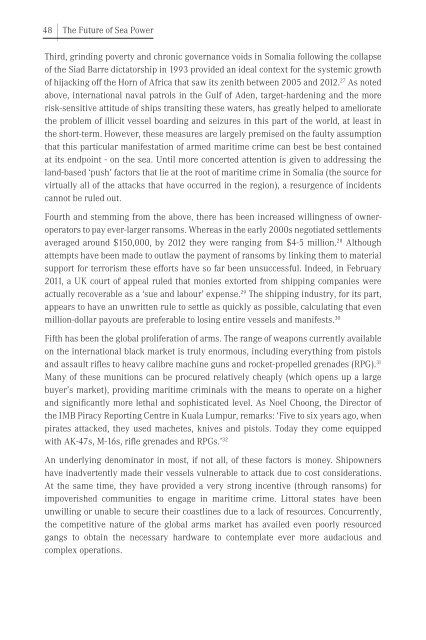THE FUTURE OF SEA POWER
SPC2015_Proceedings
SPC2015_Proceedings
Create successful ePaper yourself
Turn your PDF publications into a flip-book with our unique Google optimized e-Paper software.
48 |<br />
The Future of Sea Power<br />
Third, grinding poverty and chronic governance voids in Somalia following the collapse<br />
of the Siad Barre dictatorship in 1993 provided an ideal context for the systemic growth<br />
of hijacking off the Horn of Africa that saw its zenith between 2005 and 2012. 27 As noted<br />
above, international naval patrols in the Gulf of Aden, target-hardening and the more<br />
risk-sensitive attitude of ships transiting these waters, has greatly helped to ameliorate<br />
the problem of illicit vessel boarding and seizures in this part of the world, at least in<br />
the short-term. However, these measures are largely premised on the faulty assumption<br />
that this particular manifestation of armed maritime crime can best be best contained<br />
at its endpoint - on the sea. Until more concerted attention is given to addressing the<br />
land-based ‘push’ factors that lie at the root of maritime crime in Somalia (the source for<br />
virtually all of the attacks that have occurred in the region), a resurgence of incidents<br />
cannot be ruled out.<br />
Fourth and stemming from the above, there has been increased willingness of owneroperators<br />
to pay ever-larger ransoms. Whereas in the early 2000s negotiated settlements<br />
averaged around $150,000, by 2012 they were ranging from $4-5 million. 28 Although<br />
attempts have been made to outlaw the payment of ransoms by linking them to material<br />
support for terrorism these efforts have so far been unsuccessful. Indeed, in February<br />
2011, a UK court of appeal ruled that monies extorted from shipping companies were<br />
actually recoverable as a ‘sue and labour’ expense. 29 The shipping industry, for its part,<br />
appears to have an unwritten rule to settle as quickly as possible, calculating that even<br />
million-dollar payouts are preferable to losing entire vessels and manifests. 30<br />
Fifth has been the global proliferation of arms. The range of weapons currently available<br />
on the international black market is truly enormous, including everything from pistols<br />
and assault rifles to heavy calibre machine guns and rocket-propelled grenades (RPG). 31<br />
Many of these munitions can be procured relatively cheaply (which opens up a large<br />
buyer’s market), providing maritime criminals with the means to operate on a higher<br />
and significantly more lethal and sophisticated level. As Noel Choong, the Director of<br />
the IMB Piracy Reporting Centre in Kuala Lumpur, remarks: ‘Five to six years ago, when<br />
pirates attacked, they used machetes, knives and pistols. Today they come equipped<br />
with AK-47s, M-16s, rifle grenades and RPGs.’ 32<br />
An underlying denominator in most, if not all, of these factors is money. Shipowners<br />
have inadvertently made their vessels vulnerable to attack due to cost considerations.<br />
At the same time, they have provided a very strong incentive (through ransoms) for<br />
impoverished communities to engage in maritime crime. Littoral states have been<br />
unwilling or unable to secure their coastlines due to a lack of resources. Concurrently,<br />
the competitive nature of the global arms market has availed even poorly resourced<br />
gangs to obtain the necessary hardware to contemplate ever more audacious and<br />
complex operations.


